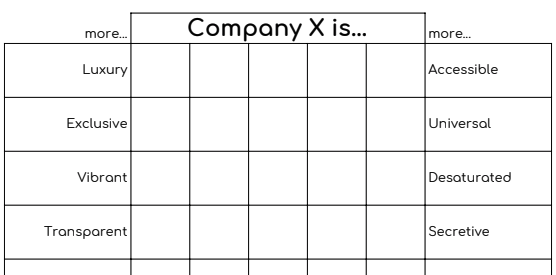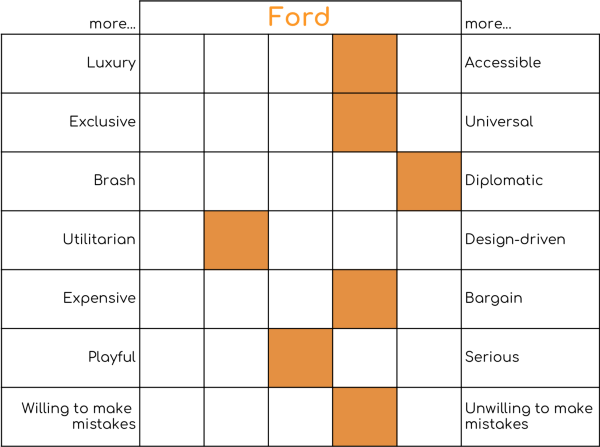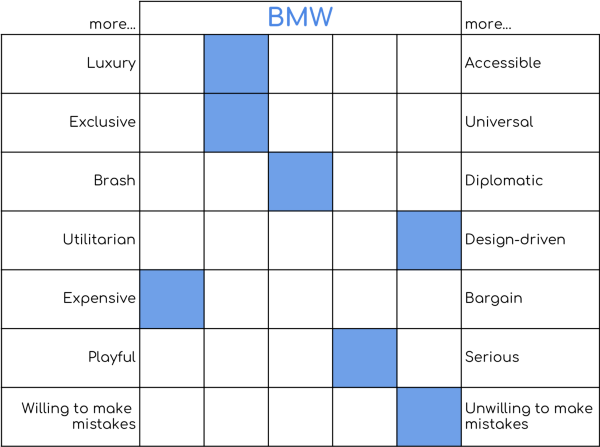
Without a personality, your products and solutions lack soul. The Bolt Brand Values Framework will help you design products people love.
This post takes a look at how to build a brand, and why brand is crucial to your startup. I’ll share the Bolt Brand Values Framework that you can use to develop your company’s personality.
Brand versus Branding
A quick note: when we’re talking about branding, we tend to talk about the visual elements of a company: colors, the tone of voice a company uses, logos, fonts, and style.
A company’s brand is all of that, and a lot more. When we think about brand, we tend to think about big, iconic brands. Consider the following: BMW, Coca-Cola, Disney, Nike and Lego. Each of these brands has a personality and a reputation. You might use words like ‘reliable,’ ‘playful,’ ‘ambitious,’ or ‘friendly’ to describe these brands. What brand boils down to is: How would you like your customers to describe your company? To influence that, you have to take an active role in shaping who your company is, why it makes the decisions it does, and how it makes those decisions.


Design language is an expression of brand
Why does your company exist? Your potential customers have a problem they’d like solved and you have a product or service that solves that problem. As human beings, we make decisions on an emotional level. That’s why building a clearly defined brand is essential to influencing a purchasing decision.
The ability to recognize a company’s products at a glance is a testament to a powerful, consistent design language.
The ability to recognize a company’s products at a glance is a testament to a powerful, consistent design language. For startups, and in particular for those creating physical products, this is particularly important. You’ve probably spotted a car on the road and thought ‘Hey, that looks like a Toyota,’ even though you might never have seen that particular model before. Or perhaps you saw a vacuum and thought ‘I don’t know who made that, but it wasn’t Dyson’. That design language didn’t appear overnight or by accident: It was carefully crafted and honed over generations of products.
To a product company, design language is an expression of brand. As a startup, it’s never too early to think about what you want that brand to be.
Who are you?
It’s easy to predict the behavior of the people you know best. Johnny is always late, but rarely more than 15 minutes. Simone will turn up 15 minutes before the party to help set up. And Robin may not turn up at all — but that makes her predictable in her flakiness.
Your company’s goal is to become as predictable as your very best friends. That personality is seeded by the company’s founders, their actions, and the way they communicate with the world. Think of your brand as your company’s personality. Are there things you would like your company to be associated with? Are there things your company would never do?

Some companies are almost exclusively brand. GoPro, Dollar Shave Club, and Casper fall into this category. There were action cameras before GoPro. People slept on mattresses before Casper. And Gilette literally invented the handle-and-razor model more than a century before Dollar Shave Club was dreamt up. I’m not saying that these companies didn’t innovate, but without the brands, there isn’t much to them.
Lean branding
You don’t need to spend tens of thousands of dollars on a design agency to get brand clarity. While you are developing your product, it’s less about logos and colors, and more about thinking about what you stand for.
Your brand value guidelines are the north star for your company. They determine the customers you pursue. It can assist in making product design decisions. It becomes a template for how you interact with your customers and how you do customer support. Everything flows from your brand — and you can get most of your early-stage branding done with a whiteboard and a marker. No designers or brand gurus required.
“A poor brand creates an incredible amount of drag,” Josh Levine, founder of the Great Monday branding agency, explains. “If you have a crappy product that doesn’t work, I can’t help you. Having a great brand won’t solve all your problems. But if your product is good, and your brand reinforces the story you’re telling, that’s a very different situation.
Brand Values Framework
The Bolt Brand Values Framework is a great tool for helping explore and decide what you want your company to stand for. It’s easy to use: There are 20+ axes to consider. Each axis helps construct your startup’s personality.


To use the Brand Values Framework:
- Copy this Google Sheet (or grab the PDF, if that’s your thing.)
- Consider each axis carefully. Discuss it with your team and place an X in the appropriate box.
- See what the strongest ‘personality traits’ of your company are. These will be most helpful in how you develop your company’s direction.

It may feel strange to think of your company as playful versus serious, but having clarity can be a great tool for design. Compare the brand values of Ford versus BMW, for example. The two companies make cars, but the over-arching brands send different messages. There are things Ford would do that BMW wouldn’t, and vice-versa.
The brand runs in the companies’ DNA, and is visible in all aspects of what they do, from advertising to customer service to product design.


None of this is set in stone. Brands can (and should) evolve — but doing so should be a conscious choice, rather than something that happens by chance. Creating a conscious set of brand values goes a long way to creating clarity about what your brand does — and what it wouldn’t do.
Where do you go from here?
Just having a ‘personality’ for your brand isn’t enough: Of course, before you start launching products to the public, you have to create a fuller brand experience and branding to go with that. You’ll need a coherent tone of voice, logo, slogans, colors, and a design language that is consistent. But if you understands the personality of your company, it becomes a lot easier to talk about all the aspects of your company’s brand — or its personality, if you will. After all, you’re now using them to describe an old friend, rather than an abstract concept.
Huge thanks to Josh Levine at Great Monday for insights that helped shape this post.
Bolt invests at the intersection of the digital and physical world.